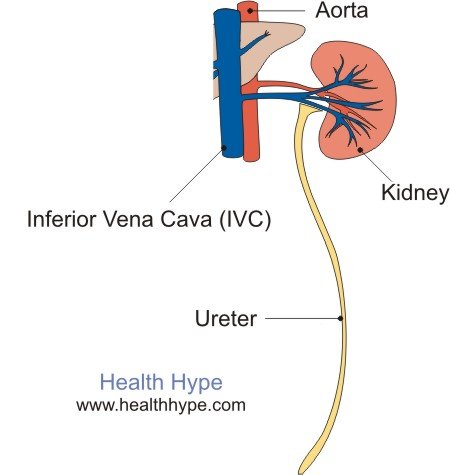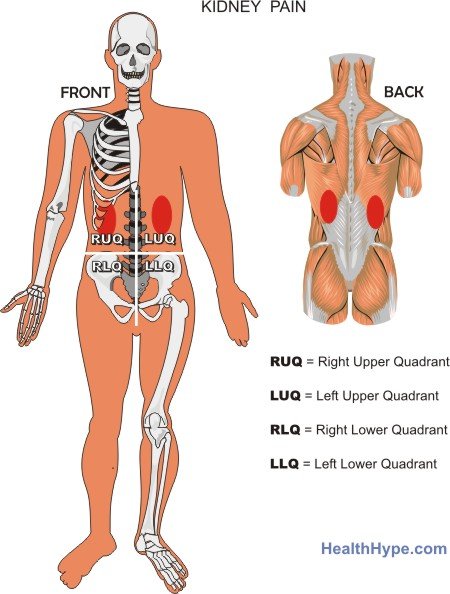Kidney Pain Location, Causes and Symptoms
What is Kidney Pain?
Kidney pain is a term often used to describe a lower back pain that is more lateral (towards the side) or around the flanks. However the kidneys, despite popular belief, are not located in the lower parts of the abdomen. The kidneys lies just below the diaphragm on either side towards the back of the abdomen in an area known as the retroperitoneal cavity. Back pain is by far the most common cause of what is termed kidney pain.
Often pain of the flanks after trauma (like a punch – “kidney punch”) or after physical exertion (like running) is mistaken for kidney pain but usually the pain is muscular in origin in both these circumstances. Pain due to other organs lying around the kidney may also be mistaken for kidney pain. In females, menstrual pain, discomfort during ovulation and pain of the fallopian tubes and/or ovaries due to a number of gynecological conditions may also be mistaken for kidney pain.
Murphy’s punch sign is a test conducted by a doctor during a physical examination where gentle tapping on the back, in line with the level of the kidney, will elicit pain due to certain infectious causes in or around the kidney.
Kidney Anatomical Location
The right kidney lies slightly lower than the left kidney because of the shape of the liver. The kidneys are well protected by pararenal fat and are situated in a position where other abdominal, chest and back structures shield it.
Depending on the level of the body, the following organs may lie next to the kidney :
- Psoas major muscle (medial to both kidneys).
- Quadratus lumborum muscle (posterior to both kidneys).
- Spleen, colon (lateral/anterolateral to left kidney) and liver and colon (lateral/anteroletral to the right kidney).
- Pancreas, small intestine (anterior to the left kidney) and liver, small intestine and inferior vena cava (anterior to right kidney).
Based on the close proximity of these other structures to the kidneys, it is difficult to isolate pain in the mid back or abdomen as being due to the kidney unless other signs and symptoms are present.
Refer to the causes of :
Signs and Symptoms Related to Kidney Pain
Many causes of kidney pain may not be accompanied by other signs and symptoms. However, pain in the mid back or flanks with one or more of the following signs and symptoms may be related to a disorder of the kidney or other organs of the urinary system (ureters, bladder, urethra). In men, the prostate may also be responsible for some of these signs and symptoms.
- Pain, burning during or eased by urination.
- Blood in the urine.
- Difficulty with urinating (straining).
- Diminished flow of urine. If swelling of the abdomen, limbs or entire body is also present, immediate medical attention is required.
- Erratic flow, hesitating during urination (‘start-stop’)
- Dribbling – drops/trickle of urine after urinating.
- Significant changes in urine color for no known reason (pale to clear urine or orange to dark brown urine).
- Sediments in the urine.
Parts of the Kidney
The kidneys are bean shaped organs that lie on either side of the upper abdomen within the retroperitoneal cavity. Refer to Kidney Pain Location. Apart from surrounding organs, the kidney directly interacts with a number of structures which can affect functioning if diseased.

The renal arteries branch off from the abdominal aorta and further branches into four or five arteries which supply blood to the kidney. This oxygen rich blood is then filtered by the kidneys where waste products and certain electrolytes may be removed or retained. Blood from the kidney returns via the renal veins which joins the inferior vena cava. The blood returns to the heart, where it will be funneled to the lungs and oxygenated. Any pathology affecting the renal arteries or veins will also affect the kidney and its functions. This can ultimately contribute to kidney pain.
The ureter carries urine from the kidney to the urinary bladder. It is a long tube that passes all the way from the upper quadrant of the abdomen (the retroperitoneum) to the perineum, which is the area within the pelvic bones. It can be affected by a number of abdominal and perineal structures which can come into close contact with it, thereby disrupting the flow and hampering the kidney from emptying its contents.
The adrenal glands, also known as the suprarenal glands, sit on the top of the kidney. These endocrine glands are known for its important role in stress response by secreting the hormones like adrenalin and cortisol. Adrenal gland disorders may also contribute to kidney pain due to its close proximity to the kidneys even though these disorders may not impact on the kidney function.
Is it Kidney Pain?
It may be kidney pain if you are also experiencing :
- Pain or burning during, before/after or eased by urination.
- Bloody urine.
- Straining to urinate.
- Reduced urine output.
- Hesitancy – ‘start-stop’ when urinating.
- Dribbling
- Changes in urine color.
- Sediments in urine.
Kidney Pain Causes
Infection
An abscess in the kidney may develop as a result of bacteria reaching the kidney through the ureter, blood or less often from other sites in the body.
Pyleonephritis is an infection of the kidney when a bacteria reach the kidney from lower down the urinary tract or from elsewhere in the body.
A renal abscess or kidney infection (pyelonephritis) may cause a fever, chills, fatigue, lack of appetite, kidney pain, blood in the urine (hematuria), and pain/burning upon urination (dysuria). A renal abscess is a very serious condition and requires immediate medical attention.
A chronic or recurring infection should be investigated further as there is some underlying cause predisposing the individual to repeated infections.
Inflammation
Kidney inflammation (nephritis) may occur for a number of reasons – as a result of infection, trauma, obstruction or the action of the immune system in certain types of autoimmune diseases. Swelling and pain are the usual features. The inflammation may also cause a loss of protein in the urine, blood in the urine and edema (swelling of the entire body or only certain parts).
Cancer
A tumor of the kidney or ureter is not uncommon. Urothelial cancers, which are one of the more common types of cancer, affect the endothelial lining of the the renal pelvis within the kidney, ureter or bladder. This may cause kidney pain, a lack of appetite, weight loss, bloody urine and reduced flow if the tumor obstructs the urine flow in any of these urinary structures.
Obstruction
Obstruction of blood flow in or out of the kidney or any blockage of the flow of urine to the bladder may cause back or abdominal pain (unilateral or bilateral flank pain), a gradual or sudden decrease in urine output, blood in the urine and other signs and symptoms depending on the cause. An obstruction of blood flow can result in ren0vascular hypertension where the pressure of the blood traveling to the kidney is increased. This can cause permanent damage of the kidney. Obstruction of the urine flow out of the kidney can cause an accumulation of urine within the kidney (hydronephrosis) which may result in swelling of the the kidney.
- Kidney stones develop within the kidney and are usually small enough to pass down the ureter, into the bladder where it is eventually passed out. Pain with reduced urine output is usually noted when it enters the ureter but while it is in the kidney, it may also restrict urine output. Some larger stones can cause obstruction of urine between the kidney and ureter or bladder and urethra.
- Renal embolism is a blood clot (thrombus) from elsewhere in the body can lodge in the renal artery (embolism) and cause partial or complete obstruction. Even with a slight blockage, the kidney function will be impaired.
- Renal artery stenosis is a narrowing of the renal artery for a number of reasons which obstructs the flow of blood into the kidney.
- Artherosclerosis (or arteriosclerosis) of the renal artery is when plaques build up in the artery wall thereby causing constriction (narrowing).
- Renal vein thrombosis is when a blood clot forms in the vessel carrying blood out of the kidney thereby partially or completely obstructing the blood flow.
- Renal vein entrapment, also known as nutcracker syndrome, is when the the left renal vein is compressed between the abdominal aorta and superior mesenteric artery, thereby obstructing the flow of blood out of the kidney.
Nutrition
Any disturbance in nutrition and fluid intake can affect the kidneys. While it may be reversible, long term disturbances can eventually lead to renal insufficiency and even kidney failure. Different types of eating disorders, dehydration, prolonged fasting, weight loss/gain or muscle bulking diets including supplements and additives like creatine and whey protein may affect the kidneys.
Poisoning
The kidney filters the blood, removing wastes and toxins and excreting it into the urine. In poisoning, the kidney may be severely affected as it has to function at its peak to remove these substances and these toxins may build up within it. Refer to Arsenic Poisoning, Fluoride Poisoning and Antifreeze Poisoning. Kidney pain, dysuria, hematuria, changes in urine color and change in output (increase or decrease) are common features of poisoning.
Trauma
Trauma to the kidney may occur as a result of assault (intentional) or accidental, like in car accident injuries. Since the kidneys are protected by many surrounding structures, other organs may also be affected due to mechanical injury. Trauma may cause inflammation or in more severe cases, it can result in renal hemorrhage.
Insufficiency and Failure
Many conditions can cause chronic renal insufficiency where the disease process hamper the kidney’s primary function of filtration due to a number of mechanisms of action. Eventually this will lead to renal failure. Apart from the range of kidney pain symptoms, edema and even itchy skin may be an indication or kidney failure.These conditions may include any of the causes mentioned above if they are chronic in nature and the following :
- Alcohol abuse.
- Amyloidosis.
- Diabetic nephropathy.
- Drug abuse (including narcotics and pharmaceutical drugs)
- Hypertension.
- Liver failure and other liver diseases.
- Poisoning, including arsenic poisoning, fluoride poisoning, antifreeze poisoning.
- Polycystic kidney disease.
- Sickle cell disease.






